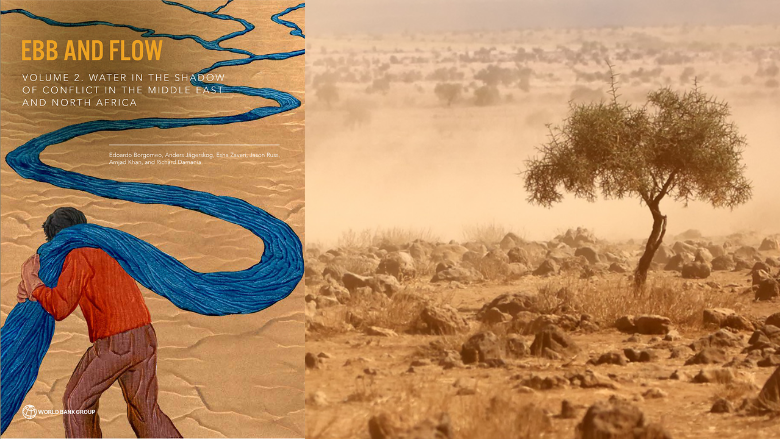This report examines the link between water and migration, and the implications for economic development. The report is based on analysis of the largest data set on internal migration ever assembled, covering nearly half a billion people from 189 population censuses in 64 countries from 1960 to 2015. It assesses how rainfall shocks are related to migration relative to other key variables such as age, gender, education, and household size. The report is in two parts. Volume 1 covers water, migration, and development. Volume 2 focuses on water, forced displacement and conflict in the Middle East and North Africa.

Volume 1 – Ebb and Flow: Water, Migration, and Development
Key messages:
Water deficits are linked to 10% of the rise in global migration. Climate change is accelerating the global water crisis: 17 countries that are home to 25% of the world population already face extremely higher levels of water stress.
- The absence of water has a greater impact on migration than an abundance of water. Rainfall shocks – when rainfall is significantly above or below the long-term average for a region – are expected to be the driving force in water-induced migration in the years ahead. Dry rainfall shocks have five times the effect on out-migration than wet rainfall shocks.
- Rainfall variability disproportionally impacts the developing world, with more than 85% of people affected living in low- or middle-income countries. Scientists project that worsening droughts will affect about 700 million people by the end of this century. Those countries most affected are usually more dependent on agricultural labor.
- The notion of a “water migrant” is an overly broad generalization not supported by the evidence. In fact, it is the poorest who often lack the means to migrate, even when doing so might improve their livelihoods and prospects. Moreover, migration in response to water deficits varies significantly based on country income, with residents of poor countries four times less likely to move relative to residents of wealthier countries. These trapped populations can encounter a triple whammy of water deficits, evaporating economic opportunities, and lack the means to move to places with better prospects.
- Water shocks affect not only the number of people who move, but also the skills they bring with them. Labor migrants who leave regions with lower rainfall and frequent dry shocks usually possess lower educational levels and skills and face a wage gap of up to 3.4% at their destination, with significant policy implications for receiving cities.
Global warming will make “day zero” events more common in the world’s cities, which are now home to 55% of the human population. Urban water supplies are under threat from rising heat stress and water scarcity. Risks to the sustainability of cities include changes in the global hydrologic cycle and water deficits in rural areas that drive agricultural workers to urban areas. Alongside recent acute water shortages in Cape Town, Chennai, and São Paolo, dozens of smaller cities face similar fates.
- It pays to invest in water. Water shocks are costly – a drought can reduce a city’s economic growth by up to 12%. Although adapting to these events can be expensive, it is crucial to invest in policies and infrastructure that enhance urban water resilience because cities drive economic growth. Recycling wastewater and harvesting storm water provides alternative water supplies that have environmental benefits. “Sponge city” concepts that improve flood protection and capture run-off create more water sources for city dwellers.
- Smart cities need smart water policies. This means designing incentives for efficient water use – and reforming inequitable and inefficient subsidies. Globally, 6 percent of water and sanitation subsidies go to the poorest 20%, while 56% goes to the wealthiest 20%. Such subsidies entrench inequality and reward inefficiency. By making water so cheap, they promote overuse, which threatens the sustainability of water services.
Governments need to protect people, livelihoods, and resources. A complementary range of policies can improve livelihoods and turn water-induced crises into opportunities.
- Provide people-centered investments. Safety nets, such as cash and in-kind transfers, can help to protect communities facing severe water shocks. Investing in water supply and sanitation, education, health care, and safe housing benefits poor migrants in urban areas and broader city populations. Active labor market policies that build skills are also needed, alongside investments in worker education and training.
- Protect livelihoods in the place of origin. Water storage and supplemental irrigation, weighed carefully to avoid unintended consequences, can effectively buffer vulnerable rural communities against water variability and scarcity. Climate-smart agriculture and farmer-led irrigation can play similar roles while minimizing the environmental footprint. And alongside built infrastructure, green infrastructure such as watersheds and their associated forests that store, filter, and distribute both surface water and groundwater, can enhance the resilience and quality of water supplies. Investing in their preservation or restoration can provide long-term benefits while boosting short-term job creation.
- Preserve and sustain urban water resources and infrastructure. As they face the growing demands of urban populations – including migrants from rural areas – and shocks to water supplies increase, the world’s cities will require increased demand-side management and greater resilience. The impervious concrete foundations on which cities lie block drainage patterns and cause water to run across the urban grid – leading to floods – and then away from the city. Cities should be redesigned to resemble sponges that soak up water and store it below ground. Flexible approaches to emergency reallocations must also be considered.
Feature story: Going With The Flow: Water’s Role in Global Migration
Press Release: Lack of Water Linked to 10 Percent of the Rise in Global Migration
Download volume 1 of the report: Ebb and Flow: Water, Migration and Development
Download background paper for volume 1: Ebb and Flow: Water, Migration and Development
Download volume 2 of the report: Ebb and Flow: Water in the Shadow of Conflict in the Middle East and North Africa
Read the report chapeau
Report key highlights
Read volume 1 appendix
Executive Summary Translations for volume 2: Arabic | French

Volume 2 - Water in the Shadow of Conflict (Middle East and North Africa)
Key messages:
Water is more often a victim and casualty of conflict – rather than a primary source of conflict – in the Middle East and North Africa (MENA). Although there have been local instances of strife and displacement in response to water concerns, there is limited evidence that water risks cause large-scale forced displacement or lead directly to conflict.
- The MENA region has the world’s highest levels of forced displacement, with an estimated 7.2 million refugees, of whom 2.7 million are hosted in the region, and 12.4 million internally displaced people fleeing protracted armed conflicts. It is also the world’s most water-scarce region, with over 60% of the population living in areas with high water stress, compared with 35% globally.
- War and unemployment are more influential drivers of migration within MENA than events related to water, such as drought. As the effects of climate change intensify, however, these historical patterns may no longer hold: in areas that lack good governance, climate change could exacerbate vulnerabilities and tensions over water resources, leading to a vicious cycle of water insecurity and fragility.
- Although conflict is an uncertain consequence of water risks, conflicts frequently lead to the targeting and destruction of water infrastructure. Since 2011, there have been at least 180 instances in which water infrastructure was targeted in Gaza, Yemen, Syria and Libya, leaving hundreds of thousands of people without access to water.
- Water is the one of the main vulnerabilities of people displaced by conflict. Access to safe drinking water is a daily struggle for millions of forcibly displaced Iraqis, Libyans, Palestinians, Syrians, Yemenis, and international migrants in the region. These challenges are particularly stark for some of the most vulnerable, such as persons with disability and women, for whom water insecurity has repercussions on mental well-being, exposure to violence and marginalization.
Contrary to popular belief, water risks have historically led more to cooperation than conflict. Within MENA, this is true at the domestic and international level – which involves transboundary rivers and aquifers. As in other parts of the world, long-term exposure to water scarcity strengthens water users’ preference for cooperation.
- Of 975 water events involving international river basins in MENA between 1948 and 2008, 56% were cooperative, 37% conflictive and 8% neutral. Given the number of armed conflicts in the region over that period, the fact that water issues have historically led to cooperation is notable.
- The apparent preference for cooperation should not induce complacency. Some 37% of the events are conflictive. Data suggests that the highest forms of transboundary water cooperation, such as treaties and agreements over shared water resources, are harder to achieve than technical and economic agreements. Formal declarations of war over water have not been registered in the historical database; however, extensive acts of violence related to water have been reported, especially in relation to the Israeli-Palestinian conflict. These include, for example, damage to water supply infrastructure in the May 2021 Gaza conflict (see World Bank Gaza Rapid Damage and Needs Assessment) and other instances reported in academic literature.
- Pre-existing socio-economic grievances in combination with a drought or a water shortage can drive domestic water tensions, especially in the absence of strong institutions. The 2018 water crisis in Basra is a stark reminder of the tensions that can arise following water shortages and declining service quality in the context of protracted armed conflict.
The MENA region urgently needs to move towards water resilience. The protracted displacement crisis and water scarcity calls for a shift from a narrow focus on humanitarian support to policies that promote long-term water security and resilience to future shocks. Given the prolonged nature of conflicts in the region, waiting for their resolution is not a feasible strategy. Development agencies need to join forces with humanitarian actors and ensure that interventions (such as drilling wells) do not undermine long-term sustainability.
An integrated framework to respond to water risks in MENA includes a series of building blocks. At the most basic level, in crisis situations, the minimum response includes partnerships with humanitarian and security actors, emergency assistance, and support for continuity of water utilities. Moving into the prevention and development stage includes two additional building blocks:
People and area-based interventions to address community grievances in access to water resources, promote labor-intensive watershed restoration, monitor and strengthen infrastructure safety, and help water service providers to win back market share.
National interventions to enhance disaster management systems, identify decentralized and low-tech infrastructure solutions, promote cost recovery and efficiency of water utilities, and focus on regulation and monitoring of groundwater abstraction.
When working towards this cooperation, policy-makers will likely face trade-offs between short-term, uncoordinated measures to respond to immediate water needs and long-term measures needed to address structural water issues. Failure to recognize and manage these trade-offs can significantly undermine water security prospects for the forcibly displaced and their host communities.
Policies to reconstruct national water institutions and infrastructure are likely to fail without the foundations of a renewed social fabric and trust in institutions, which can be achieved through people- and area-based interventions.
This broad policy focus goes well beyond forced displacement and acute crises, and involves seeing water with a new lens across MENA. This is crucial for growth and development in a region that faces the greatest expected economic losses from climate-related water scarcity, estimated at 6–14 percent of GDP by 2050 (see High and Dry: Climate Change, Water, and the Economy, World Bank, 2016).
Press release in Arabic
Key messages in Arabic
Executive Summary Translations for volume 2: Arabic | French